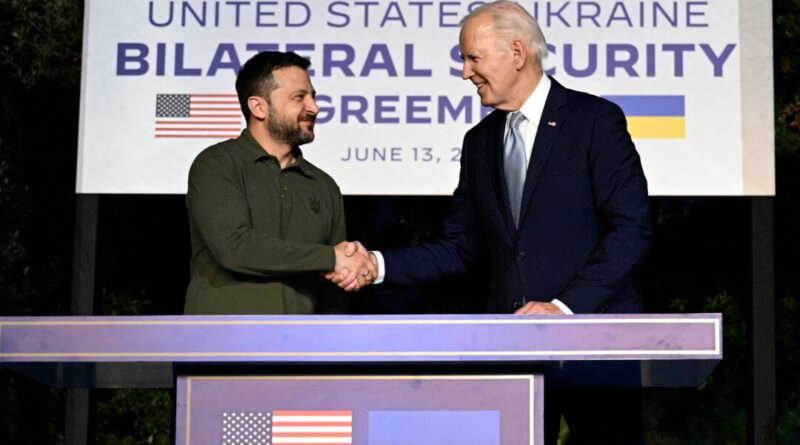White House Reveals Plan for Utilizing Russian Assets in G7 Strategy
The total amount of $50 billion in loans will be sent to Ukraine this year, with repayment of the loans coming from the income on immobilized Russian assets.
The White House on June 14 outlined some of the technical details of the plan agreed by Group of Seven (G7) leaders to grant loans to Ukraine using frozen Russian sovereign assets.
“Every G7 country is going to do its part,” a senior administration official said during a call with reporters. “Some countries are going to contribute to the loan. Others will contribute to the repayment. Others still will provide guarantees of repayment if the income flow isn’t sufficient to service and repay the loan in full.”
The G7 leaders on June 13 announced that they had struck an agreement to unlock some $300 billion worth of Russian assets, which will be utilized to support Ukraine during the continuing war with Russia and the reconstruction.
According to the agreement, a total amount of $50 billion in so-called “Extraordinary Revenue Acceleration (ERA) Loans” will be sent to Ukraine this year. The repayment of the loan will come from the interest income generated from these Russian assets—most of which are held within the European Union.
“There was, of course, unanimous agreement that when it comes to financing the eventual reconstruction of Ukraine, it’s only fair that Russia, not our taxpayers, foot the bill,” the senior administration official said.
Participating Countries
The United States is willing to commit up to $50 billion, but the senior administration official confirmed that it would not be the only lender. Canada has pledged to contribute $5 billion, and both Europe and Japan are considering how much they want to contribute.
Meanwhile, the UK is considering a way to guarantee the repayment of the loans, and the European Union will play “a very large role” in providing the interest income that will come from the Russian assets. However, there is one major step the Europeans need to take.
France, Germany, and Italy are going to have to appeal to the other members of the European Union to ensure the continued immobilization of the Russian assets. However, the Biden administration exuded confidence that European leaders would ensure that immobilization continued.
“We fully expect that the EU 27 will meet this moment and, with the G7’s direction, authorize the continued immobilization of Russia’s sovereign assets,” the senior administration official said. “The reason I say that is, is that European G7 countries have now committed at the highest political levels to seek that approval from Brussels.”
After approval, Europe will decide how much of the $50 billion loan to take on. It might be half the loan, the senior administration official said.
He also pointed out that a significant share of the immobilized assets are in Belgium and hence the country “will continue to play a very constructive role as partners in this effort.”
How Will Ukraine Get the Money?
The direction of the loan will vary depending on the lender. For example, while Europe would prefer to direct its loan contribution to the Ukrainian military, Japan has a legal requirement to keep its contributions away from military purposes.
“We intend to disburse this financing through multiple channels that direct the funds to Ukraine’s military, budget, and reconstruction needs—within the constraints of our respective legal systems and administrative requirements,” the G7 leaders said in their joint statement.
Since the loan will be repaid with proceeds from the Russian assets, Ukraine will be able to treat these funds as a grant.
“That’s important because if it’s not expected to repay any portion of the loan from its own budget, it doesn’t change Ukraine’s debt-to-GDP ratio,” the senior administration official said.
The G7 leaders also announced that they would strengthen the already-existent Ukraine Multi-Donor Coordination Platform in order to disperse funds during reconstruction in a way that’s aligned with Ukraine’s highest priority needs.
Some $300 billion worth of frozen assets are currently kept in European accounts, and the World Bank estimates that the damages Ukraine has received during this war now exceed $486 billion.
‘We’re Not Backing Down’
This agreement was made amid President Joe Biden’s signing of a 10-year security pact with Ukrainian President Volodymyr Zelenskyy on the sidelines of the G7 summit in Puglia.
During a joint news conference on June 13, President Biden called the agreement to utilize the frozen assets, “Another reminder to Putin: We’re not backing down. In fact, we’re standing together against this illegal aggression.”
Mr. Zelenskyy called the $50 billion loan a “vital step forward in providing sustainable support for Ukraine in winning this war.”
“Russian immobilized assets should be used for defending the lives of Ukrainians from Russian terror and for repairing the damage [the] aggressor caused to Ukraine,” Mr. Zelenskyy said. “It’s fair and absolutely right.”
Meanwhile, Russian President Vladimir Putin said on June 14 that plans by G7 countries to provide Ukraine with loans using Russian frozen assets was “theft” and would not go unpunished.






